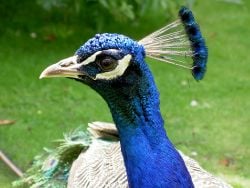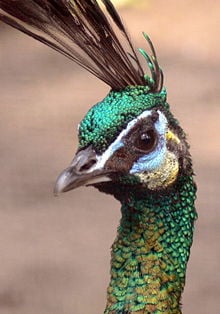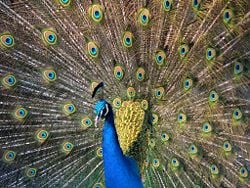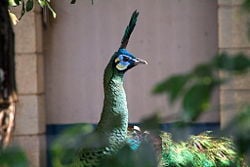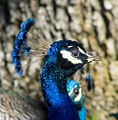Difference between revisions of "Peafowl" - New World Encyclopedia
Rick Swarts (talk | contribs) |
Rosie Tanabe (talk | contribs) |
||
| (16 intermediate revisions by 3 users not shown) | |||
| Line 1: | Line 1: | ||
| + | {{Images OK}}{{Approved}}{{copyedited}} | ||
{{Taxobox | {{Taxobox | ||
| name = Peafowl | | name = Peafowl | ||
| image = peacock_courting_peahen.jpg | | image = peacock_courting_peahen.jpg | ||
| image_width = 250px | | image_width = 250px | ||
| − | | image_caption = An Indian | + | | image_caption = An Indian blue peacock (rear) courts a peahen (front) |
| regnum = [[Animal]]ia | | regnum = [[Animal]]ia | ||
| phylum = [[Chordate|Chordata]] | | phylum = [[Chordate|Chordata]] | ||
| Line 11: | Line 12: | ||
| subdivision_ranks = [[Species]] | | subdivision_ranks = [[Species]] | ||
| subdivision = | | subdivision = | ||
| − | ''[[Pavo cristatus]]''<br> | + | ''[[Pavo cristatus]]''<br/> |
''[[Pavo muticus]]'' | ''[[Pavo muticus]]'' | ||
}} | }} | ||
| − | '''Peafowl''' is the common name for members of two [[species]] of large [[bird]]s of the [[pheasant]] [[family (biology)|family]] [[Phasianidae]], '''''Pavo cristatus''''' (Indian peafowl) and '''Pavo muticus''' (green peafowl), characterized by crested heads, long legs, heavy wings, and resplendent blue or green plumage, as well as brilliant, | + | '''Peafowl''' is the common name for members of two [[species]] of large [[bird]]s of the [[pheasant]] [[family (biology)|family]] [[Phasianidae]], '''''Pavo cristatus''''' (Indian peafowl) and '''Pavo muticus''' (green peafowl), characterized by crested heads, long legs, heavy wings, and resplendent blue or green plumage, as well as males having long, brilliant, back [[feather]]s (upper tail coverts) that can be erected and fanned out and have iridescent, eye-like spots. While technically the male is a '''peacock''' and the female a '''peahen,''' the term peacock often is used for the both the males and the females or the female may be referred to as a "female peacock." The term peafowl also is used for another member of the family in another genus, the African Congo peafowl, '''Afropavo congensis,''' but this article will be limited to the two members of the ''Pavo'' genus. |
| − | + | {{toc}} | |
| − | + | Peafowl are best known for the male's extravagant "tail" which is displayed as part of [[courtship]]. While this feature advanced the peafowl's individual function of reproduction, it has also made the peafowl a well-known ornamental bird, bring delight to people. Ecologically, they provide a role as part of terrestrial [[food chain]]s, consuming various invertebrates, small vertebrates, and plant matter, and being consumed by larger animals and predatory birds. In particular, the chicks and peahens are at risk when they nest on the ground but as adults their roosting in trees offers greater protection. | |
| − | |||
| − | Peafowl are best known for the male's extravagant [[ | ||
==Overview and description== | ==Overview and description== | ||
| − | Peafowl are members of the [[Galliformes]] family '''Phasianidae''' | + | Peafowl are members of the [[Galliformes]] family '''Phasianidae,''' which also includes the [[pheasant]]s, quail, partridges, and junglefowl. These are terrestrial species, variable in size, but generally are plump, with broad relatively short [[wing]]s. Many have a [[spur]] on their [[leg]]s. Males of the larger [[species]] often are brightly colored. |
| + | [[Image:PeacockHead.jpg|thumb|right|250px|An Indian blue peacock's head]] | ||
| + | [[Image:Pavo muticus3.jpg|thumb|right|220px|A green peahen's head]] | ||
The two species known as peafowl are: | The two species known as peafowl are: | ||
| − | *[[Indian | + | *[[Indian peafowl]], ''Pavo cristatus'' (Asiatic), also known as common peafowl or blue peafowl. |
| − | *[[Green | + | *[[Green peafowl]], ''Pavo muticus'' (Asiatic) |
| − | The Indian peafowl is a resident breeder in the [[Indian subcontinent | + | The Indian peafowl is a resident breeder in the [[Indian subcontinent]]. The green peafowl breeds from [[Burma]] east to [[Java (island)|Java]]. The [[IUCN]] lists the green peafowl as vulnerable to extinction due to hunting and a reduction in extent and quality of habitat. |
| − | These two species are spectacularly plumaged birds and are the largest members of the Phasianidae. Males and females of both species have a crest atop the head. The males of both species have highly elongated and elaborated "trains" or "tails," which are decorated with metallic [[ocellus|ocelli]]. While commonly called tails, these are actually the uppertail [[covert]] feathers, while the peacock's tail is much shorter and stiff and helps to prop up the train during display. Covert feathers, as the name implies, cover other feathers, with the uppertail coverts covering above the base of the tail feathers. | + | These two species are spectacularly plumaged birds and are the largest members of the Phasianidae. Males and females of both species have a crest atop the head. The males of both species have highly elongated and elaborated "trains" or "tails," which are decorated with metallic [[ocellus|ocelli]]. While commonly called tails, these are actually the uppertail [[covert]] feathers, while the peacock's tail is much shorter and stiff and helps to prop up the train during display. Covert feathers, as the name implies, cover other feathers, with the uppertail coverts covering above the base of the tail feathers. |
| − | The peafowl are forest birds. They are terrestrial feeders but roost in trees. During mating season they will often emit a very loud high pitched cry. | + | The peafowl are forest birds. They are terrestrial feeders and nest on the ground to raise their young, but they can fly and they roost in trees. During mating season they will often emit a very loud high pitched cry. |
| − | Peafowl are omnivorous and eat ticks, termites, ants, locusts, mice, plant parts, flower petals, seed heads, scorpions, | + | Peafowl are omnivorous and eat ticks, termites, ants, locusts, mice, plant parts, flower petals, seed heads, scorpions, other arthropods, reptiles, and amphibians. |
===Plumage=== | ===Plumage=== | ||
| − | [[Image:Pfau imponierend.jpg|thumb|250px|right|Close-up of a male Indian | + | [[Image:Pfau imponierend.jpg|thumb|250px|right|Close-up of a male Indian peafowl's plumage]] |
The male (peacock) Indian peafowl has iridescent blue-green or green colored plumage. The so-called "tail" of the peacock, also termed the "train," consists of highly elongated upper tail [[covert feather|covert]]s. The train feathers have a series of eyes that are best seen when the train is fanned. The actual tail feathers are short and gray-colored and can be seen from behind when a peacock's train is fanned in a courtship display. During the molting season, the males shed their stunning train feathers and reveal the unassuming gray-colored tail that is normally hidden from view beneath the train. | The male (peacock) Indian peafowl has iridescent blue-green or green colored plumage. The so-called "tail" of the peacock, also termed the "train," consists of highly elongated upper tail [[covert feather|covert]]s. The train feathers have a series of eyes that are best seen when the train is fanned. The actual tail feathers are short and gray-colored and can be seen from behind when a peacock's train is fanned in a courtship display. During the molting season, the males shed their stunning train feathers and reveal the unassuming gray-colored tail that is normally hidden from view beneath the train. | ||
| − | The female (peahen) Indian | + | The female (peahen) Indian peafowl has a mixture of dull green, brown, and gray in her plumage. She lacks the long upper tail coverts of the male but has a crest. The female can also display her plumage to ward off female competition or danger to her young. |
The green peafowl is very different in appearance to the Indian peafowl. The male has green and gold plumage and has an erect crest. The wings are black with a sheen of blue. Unlike the Indian peafowl, the green peahen is very similar to the male, only having shorter upper tail coverts and slightly less iridescent in some regions. Like other peafowl, it is very difficult to distinguish a juvenile male from an adult female. Moreover, the sexes of the various green peafowl species are almost impossible to tell apart in the field during the months when the male has no train. | The green peafowl is very different in appearance to the Indian peafowl. The male has green and gold plumage and has an erect crest. The wings are black with a sheen of blue. Unlike the Indian peafowl, the green peahen is very similar to the male, only having shorter upper tail coverts and slightly less iridescent in some regions. Like other peafowl, it is very difficult to distinguish a juvenile male from an adult female. Moreover, the sexes of the various green peafowl species are almost impossible to tell apart in the field during the months when the male has no train. | ||
| Line 49: | Line 50: | ||
Such interference-based ''structural color'' is especially important in producing the peacock's [[iridescent]] hues (which shimmer and change with viewing angle), since interference effects depend upon the angle of light, unlike chemical pigments. | Such interference-based ''structural color'' is especially important in producing the peacock's [[iridescent]] hues (which shimmer and change with viewing angle), since interference effects depend upon the angle of light, unlike chemical pigments. | ||
| − | [[Image:Peacock rear - melbourne zoo.jpg|thumb|right| | + | [[Image:Peacock rear - melbourne zoo.jpg|thumb|right|225px|A rear view of an [[Indian blue peacock]]'s tail feathers.]] |
| − | |||
==Habitat== | ==Habitat== | ||
| Line 57: | Line 57: | ||
Because of human encroachment into their natural territories, peafowl and humans have come into increasing contact. Because of their natural beauty some are reluctant to classify the birds as pests; however, their presence can be disturbing, especially given their tendency to eat indiscriminately of garden boundaries and the male's powerful vocal crow (louder than a rooster's crow). | Because of human encroachment into their natural territories, peafowl and humans have come into increasing contact. Because of their natural beauty some are reluctant to classify the birds as pests; however, their presence can be disturbing, especially given their tendency to eat indiscriminately of garden boundaries and the male's powerful vocal crow (louder than a rooster's crow). | ||
| − | Peafowl have left captivity and developed permanent, free-roaming populations in several parts of the world including [[Coconut Grove, Miami, Florida]] and [[Arcadia, California]]. | + | Peafowl have left captivity and developed permanent, free-roaming populations in several parts of the world including [[Coconut Grove, Miami, Florida]], and [[Arcadia, California]]. |
| − | |||
==Species== | ==Species== | ||
| − | [[Image:Green Peafowl Male.jpg|thumb|250px|right|Green | + | [[Image:Green Peafowl Male.jpg|thumb|250px|right|Green peafowl]] |
| − | The Indian peafowl is [[monotypic]], while the green peafowl has three described subspecies, ''P. muticus spicifer'', ''P. m. imperator'' | + | The Indian peafowl is [[monotypic]], while the green peafowl has three described subspecies, ''P. muticus spicifer'', ''P. m. imperator,'' and the nominate ''P. m. muticus'' (Madge and McGowan 2002). The two species are largely [[allopatric]] but will hybridize in captivity. |
===Indian peafowl=== | ===Indian peafowl=== | ||
| − | The '''Indian peafowl''' | + | The '''Indian peafowl,''' ''Pavo cristatus,'' also known as the common peafowl or the blue peafowl, is the largest Asian [[galliform]]. It is found in the [[Indian subcontinent]] and has been introduced into many parts of the world and feral populations exist in many introduced regions. The species is found in dry semi-desert grasslands, scrub, and deciduous forests. It forages and nests on the ground but roosts on top of trees. It eats seeds, insects, fruits, small mammals, and reptiles. |
| − | |||
| − | |||
| − | Females are about 86 centimeters (34 inches) long and weigh 2.75 to 4 kilograms (6-8.8 lbs), while males average at about 2.12 meters (7.3 feet) in full breeding plumage (107 cm/42 in when not) and weigh 4-6 kilograms (8.8-13.2 lbs). The Indian | + | Females are about 86 centimeters (34 inches) long and weigh 2.75 to 4 kilograms (6-8.8 lbs), while males average at about 2.12 meters (7.3 feet) in full breeding plumage (107 cm/42 in when not) and weigh 4-6 kilograms (8.8-13.2 lbs). The Indian peacock has iridescent blue-green plumage. The upper tail coverts on its back are elongated and ornate with an eye at the end of each feather. These are the peacock's display feathers. The female plumage is a mixture of dull green, gray, and [[iridescent]] blue, with the greenish-gray predominating. In the breeding season, females stand apart by lacking the long "tail feathers" or "train," and in the non-breeding season they can be distinguished from males by the green color of the neck as opposed to the blue on the males. |
===Green peafowl=== | ===Green peafowl=== | ||
| − | The '''Green peafowl''' | + | The '''Green peafowl,''' ''Pavo muticus,'' is found in the tropical forests of [[Southeast Asia]]. The sexes of green peafowl, or "dragonbirds" as they are known in their native haunts, are quite similar in appearance, especially in the field. During most of the year, when the males have no visible trains, it is quite difficult to distinguish the sexes. Bot sexes carry tall pointed crests and are long legged and heavy winged and long tailed in silhouette. Seen in the distance, they are generally dark colored birds with pale vermilion or buff colored primaries, which are quite visible in in their peculiar flight. Their flight has been described as a true flapping flight (Baker and Beebe) with little of the gliding that one associates with galliformes. Some ecological species of green peafowl are distinctly bluer in appearance, while others are decidedly bronze and purple ([[Yunnan]]), or dull gold and emerald (Javanese), bright citrus green and cerulean blue (Annametic), or blackish gray and violet blue with purple trains (spicifer) |
==Gallery== | ==Gallery== | ||
| − | ===Indian | + | ===Indian peafowl=== |
<gallery> | <gallery> | ||
| − | |||
Image:Peacock_00782.jpg|Shot of <!-- possibly the same? —>a white peacock | Image:Peacock_00782.jpg|Shot of <!-- possibly the same? —>a white peacock | ||
| − | Image:Oregon zoo peacock male.jpg|Indian | + | Image:Oregon zoo peacock male.jpg|Indian blue peacock, male |
| − | Image:Peahen on Saint Thomas, United States Virgin Islands.jpg|An Indian | + | Image:Peahen on Saint Thomas, United States Virgin Islands.jpg|An Indian blue peahen showing her plumage |
| − | + | Image:Male Indian Blue Peacock head.jpg|The head of a male Indian blue peacock | |
| − | + | Image:Bottom of plate CXLII from 1st Encyclopaedia Britannica.jpg|Indian blue peacocks as illustrated in the First Edition of the [[Encyclopædia Britannica]] | |
| − | |||
| − | Image:Male Indian Blue Peacock head.jpg|The head of a male Indian | ||
| − | |||
| − | Image:Bottom of plate CXLII from 1st Encyclopaedia Britannica.jpg|Indian | ||
Image:Charles d'Orbigney00.jpg|by [[Charles d'Orbigney]] (1806–1876) | Image:Charles d'Orbigney00.jpg|by [[Charles d'Orbigney]] (1806–1876) | ||
| − | |||
Image:White_peacock.JPG | White peacock shot in [[Sydney]], [[Australia]] | Image:White_peacock.JPG | White peacock shot in [[Sydney]], [[Australia]] | ||
Image:Peacock 2.JPG | Peacock seen in [[San Francisco]], [[California]] | Image:Peacock 2.JPG | Peacock seen in [[San Francisco]], [[California]] | ||
</gallery> | </gallery> | ||
| − | ===Green | + | ===Green peafowl=== |
<gallery> | <gallery> | ||
Image:Pavo muticus1.jpg|Male | Image:Pavo muticus1.jpg|Male | ||
Image:Pavo muticus2.jpg|Female | Image:Pavo muticus2.jpg|Female | ||
| − | |||
Image:Stavenn Pavo muticus 01.jpg | Image:Stavenn Pavo muticus 01.jpg | ||
| − | |||
</gallery> | </gallery> | ||
==References== | ==References== | ||
| − | |||
| − | |||
| − | |||
| − | |||
| − | |||
| − | |||
| − | |||
| − | |||
| − | |||
| − | |||
| − | |||
| − | |||
| − | |||
| − | |||
| − | |||
| − | |||
| − | |||
| − | |||
| − | |||
| − | |||
| − | |||
| − | |||
| − | |||
| − | |||
| − | |||
| − | |||
| − | |||
| − | |||
| − | |||
| − | |||
| − | |||
| − | |||
| − | |||
| − | |||
| − | |||
| − | |||
| − | |||
| − | |||
| − | |||
| − | |||
| − | |||
| − | |||
| − | |||
| − | |||
| − | |||
| − | |||
| − | |||
| − | |||
| − | |||
| − | |||
| − | |||
| − | |||
| − | |||
| − | |||
| − | |||
| − | |||
| − | |||
| − | |||
| − | |||
| − | |||
| − | + | * Kimball, R.T., E.L. Braun, and J.D. Ligon. 1997. [https://www.ncbi.nlm.nih.gov/pmc/articles/PMC1688693/ Resolution of the phylogenetic position of the Congo peafowl, ''Afropavo congensis:'' A biogeographic and evolutionary enigma] ''Proceedings: Biological Sciences'' 264(1387): 1517-1523. Retrieved February 26, 2021. | |
| + | * Madge, S., P.J.K. McGowan, and G.M. Kirwan. 2002. ''Pheasants, Partridges and Grouse''. London: Christopher Helm. ISBN 0713639660. | ||
| + | * van Balen, S., D.M. Prawiradilaga, and M. Indrawan. 1995. [https://www.sciencedirect.com/science/article/abs/pii/000632079400048U The distribution and status of green peafowl in Java] ''Biol. Conserv.'' 71: 289-297. Retrieved February 26, 2021. | ||
==External links== | ==External links== | ||
| − | + | All links retrieved November 23, 2022. | |
| − | + | *[https://avibirds.com/indian-peafowl/ The Indian Peafowl – The Most Fascinating Bird In The World] | |
| − | |||
| − | |||
| − | * [ | ||
| − | |||
| − | |||
| − | |||
| − | |||
[[Category:Life sciences]] | [[Category:Life sciences]] | ||
Latest revision as of 07:08, 23 November 2022
| Peafowl | ||||||||||
|---|---|---|---|---|---|---|---|---|---|---|
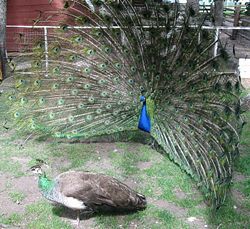 An Indian blue peacock (rear) courts a peahen (front)
| ||||||||||
| Scientific classification | ||||||||||
| ||||||||||
|
Pavo cristatus |
Peafowl is the common name for members of two species of large birds of the pheasant family Phasianidae, Pavo cristatus (Indian peafowl) and Pavo muticus (green peafowl), characterized by crested heads, long legs, heavy wings, and resplendent blue or green plumage, as well as males having long, brilliant, back feathers (upper tail coverts) that can be erected and fanned out and have iridescent, eye-like spots. While technically the male is a peacock and the female a peahen, the term peacock often is used for the both the males and the females or the female may be referred to as a "female peacock." The term peafowl also is used for another member of the family in another genus, the African Congo peafowl, Afropavo congensis, but this article will be limited to the two members of the Pavo genus.
Peafowl are best known for the male's extravagant "tail" which is displayed as part of courtship. While this feature advanced the peafowl's individual function of reproduction, it has also made the peafowl a well-known ornamental bird, bring delight to people. Ecologically, they provide a role as part of terrestrial food chains, consuming various invertebrates, small vertebrates, and plant matter, and being consumed by larger animals and predatory birds. In particular, the chicks and peahens are at risk when they nest on the ground but as adults their roosting in trees offers greater protection.
Overview and description
Peafowl are members of the Galliformes family Phasianidae, which also includes the pheasants, quail, partridges, and junglefowl. These are terrestrial species, variable in size, but generally are plump, with broad relatively short wings. Many have a spur on their legs. Males of the larger species often are brightly colored.
The two species known as peafowl are:
- Indian peafowl, Pavo cristatus (Asiatic), also known as common peafowl or blue peafowl.
- Green peafowl, Pavo muticus (Asiatic)
The Indian peafowl is a resident breeder in the Indian subcontinent. The green peafowl breeds from Burma east to Java. The IUCN lists the green peafowl as vulnerable to extinction due to hunting and a reduction in extent and quality of habitat.
These two species are spectacularly plumaged birds and are the largest members of the Phasianidae. Males and females of both species have a crest atop the head. The males of both species have highly elongated and elaborated "trains" or "tails," which are decorated with metallic ocelli. While commonly called tails, these are actually the uppertail covert feathers, while the peacock's tail is much shorter and stiff and helps to prop up the train during display. Covert feathers, as the name implies, cover other feathers, with the uppertail coverts covering above the base of the tail feathers.
The peafowl are forest birds. They are terrestrial feeders and nest on the ground to raise their young, but they can fly and they roost in trees. During mating season they will often emit a very loud high pitched cry.
Peafowl are omnivorous and eat ticks, termites, ants, locusts, mice, plant parts, flower petals, seed heads, scorpions, other arthropods, reptiles, and amphibians.
Plumage
The male (peacock) Indian peafowl has iridescent blue-green or green colored plumage. The so-called "tail" of the peacock, also termed the "train," consists of highly elongated upper tail coverts. The train feathers have a series of eyes that are best seen when the train is fanned. The actual tail feathers are short and gray-colored and can be seen from behind when a peacock's train is fanned in a courtship display. During the molting season, the males shed their stunning train feathers and reveal the unassuming gray-colored tail that is normally hidden from view beneath the train.
The female (peahen) Indian peafowl has a mixture of dull green, brown, and gray in her plumage. She lacks the long upper tail coverts of the male but has a crest. The female can also display her plumage to ward off female competition or danger to her young.
The green peafowl is very different in appearance to the Indian peafowl. The male has green and gold plumage and has an erect crest. The wings are black with a sheen of blue. Unlike the Indian peafowl, the green peahen is very similar to the male, only having shorter upper tail coverts and slightly less iridescent in some regions. Like other peafowl, it is very difficult to distinguish a juvenile male from an adult female. Moreover, the sexes of the various green peafowl species are almost impossible to tell apart in the field during the months when the male has no train.
Many of the brilliant colors of the peacock plumage are due to an optical interference phenomenon (Bragg reflection) based on (nearly) periodic nanostructures found in the barbules (fiber-like components) of the feathers.
Different colors correspond to different length scales of the periodic structures. For brown feathers, a mixture of red and blue is required: one color is created by the periodic structure, and the other is a created by a Fabry-Perot interference peak from reflections off the outermost and innermost boundaries of the periodic structure.
Such interference-based structural color is especially important in producing the peacock's iridescent hues (which shimmer and change with viewing angle), since interference effects depend upon the angle of light, unlike chemical pigments.
Habitat
Asiatic peafowl occupy a similar niche as the roadrunners, Secretary Bird, and seriemas. All of these birds hunt for small animals including arthropods on the ground and tall grass and minnows in shallow streams.
Because of human encroachment into their natural territories, peafowl and humans have come into increasing contact. Because of their natural beauty some are reluctant to classify the birds as pests; however, their presence can be disturbing, especially given their tendency to eat indiscriminately of garden boundaries and the male's powerful vocal crow (louder than a rooster's crow).
Peafowl have left captivity and developed permanent, free-roaming populations in several parts of the world including Coconut Grove, Miami, Florida, and Arcadia, California.
Species
The Indian peafowl is monotypic, while the green peafowl has three described subspecies, P. muticus spicifer, P. m. imperator, and the nominate P. m. muticus (Madge and McGowan 2002). The two species are largely allopatric but will hybridize in captivity.
Indian peafowl
The Indian peafowl, Pavo cristatus, also known as the common peafowl or the blue peafowl, is the largest Asian galliform. It is found in the Indian subcontinent and has been introduced into many parts of the world and feral populations exist in many introduced regions. The species is found in dry semi-desert grasslands, scrub, and deciduous forests. It forages and nests on the ground but roosts on top of trees. It eats seeds, insects, fruits, small mammals, and reptiles.
Females are about 86 centimeters (34 inches) long and weigh 2.75 to 4 kilograms (6-8.8 lbs), while males average at about 2.12 meters (7.3 feet) in full breeding plumage (107 cm/42 in when not) and weigh 4-6 kilograms (8.8-13.2 lbs). The Indian peacock has iridescent blue-green plumage. The upper tail coverts on its back are elongated and ornate with an eye at the end of each feather. These are the peacock's display feathers. The female plumage is a mixture of dull green, gray, and iridescent blue, with the greenish-gray predominating. In the breeding season, females stand apart by lacking the long "tail feathers" or "train," and in the non-breeding season they can be distinguished from males by the green color of the neck as opposed to the blue on the males.
Green peafowl
The Green peafowl, Pavo muticus, is found in the tropical forests of Southeast Asia. The sexes of green peafowl, or "dragonbirds" as they are known in their native haunts, are quite similar in appearance, especially in the field. During most of the year, when the males have no visible trains, it is quite difficult to distinguish the sexes. Bot sexes carry tall pointed crests and are long legged and heavy winged and long tailed in silhouette. Seen in the distance, they are generally dark colored birds with pale vermilion or buff colored primaries, which are quite visible in in their peculiar flight. Their flight has been described as a true flapping flight (Baker and Beebe) with little of the gliding that one associates with galliformes. Some ecological species of green peafowl are distinctly bluer in appearance, while others are decidedly bronze and purple (Yunnan), or dull gold and emerald (Javanese), bright citrus green and cerulean blue (Annametic), or blackish gray and violet blue with purple trains (spicifer)
Gallery
Indian peafowl
Peacock seen in San Francisco, California
Green peafowl
ReferencesISBN links support NWE through referral fees
- Kimball, R.T., E.L. Braun, and J.D. Ligon. 1997. Resolution of the phylogenetic position of the Congo peafowl, Afropavo congensis: A biogeographic and evolutionary enigma Proceedings: Biological Sciences 264(1387): 1517-1523. Retrieved February 26, 2021.
- Madge, S., P.J.K. McGowan, and G.M. Kirwan. 2002. Pheasants, Partridges and Grouse. London: Christopher Helm. ISBN 0713639660.
- van Balen, S., D.M. Prawiradilaga, and M. Indrawan. 1995. The distribution and status of green peafowl in Java Biol. Conserv. 71: 289-297. Retrieved February 26, 2021.
External links
All links retrieved November 23, 2022.
Credits
New World Encyclopedia writers and editors rewrote and completed the Wikipedia article in accordance with New World Encyclopedia standards. This article abides by terms of the Creative Commons CC-by-sa 3.0 License (CC-by-sa), which may be used and disseminated with proper attribution. Credit is due under the terms of this license that can reference both the New World Encyclopedia contributors and the selfless volunteer contributors of the Wikimedia Foundation. To cite this article click here for a list of acceptable citing formats.The history of earlier contributions by wikipedians is accessible to researchers here:
The history of this article since it was imported to New World Encyclopedia:
Note: Some restrictions may apply to use of individual images which are separately licensed.
